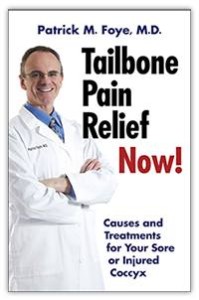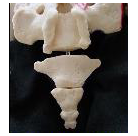When there is skin breakdown of ulceration of the skin over the coccyx, it is worth looking for a cause.
- Sometimes people develop a bed-sore of the skin behind the sacrum and coccyx after spending too much time laying in bed. (The medical term for a bedsore is a “decubitus ulcer”.)
- Usually, a bedsore will heal once the person is more active (spending less time laying in bed) or with more frequent repositioning in bed (such as having the nurses or family roll the patient in bed every two hours, in order to give the skin a chance to heal and ‘breathe’).
- But in some cases the skin breakdown may persist or it may come back.
- Or sometimes the skin has delayed healing after a coccygectomy (surgical amputation of the coccyx). Normally a surgical site will close and heal, but sometimes this is delayed or there are problems with healing at the post-operative site. There may even be “dehiscence”, which is also called “wound separation.” (Dehiscence means that the edges of the wound no longer meet, and this can result in delayed healing and increased risk for the wound to become infected.)
If the skin breakdown persists or returns, consider these possible causes:
2) Underlying immune compromise? Particularly if there is any recurring infection, then it would be worthwhile asking your primary care doctor to check whether there is any underlying compromise of your immune system that might be putting you at risk for these persistent or recurrent infections. This would typically mean checking for things like HIV/AIDS, certain cancers especially certain leukemias (blood cancers involving the white blood cells), etc.. A consultation with an “Infectious Disease” (ID) physician specialist may be helpful.
3) Nutritional deficiencies? Admittedly, most people eating a normal diet probably do not have a nutritional deficiency that is responsible for a wound failing to heal. But it is worth considering, especially if someone is only eating some kind of very restricted diet that fails to give a balance of multiple food groups.
4) Anal fistula or rectal fistula? Sometimes people develop a small tear inside the anus or within the wall of the rectum. Eventually this can form into a tunnel or track (“fistula”). This tunnel can take stool or bacteria from the bowels into nearby tissue, causing infection of those tissues. To evaluate for this possibility typically would require seeing a gastroenterologist (a physician who is a “G.I.” [gastrointestinal] specialist). Tests for this sometimes could involve putting contrast (medical dye) into the rectum and seeing if it fills up the tunnel, which would then be visible on imaging studies done after the dye is put in place.
Treatments can vary
- Antibiotics can be given to resolve infection at the wound site.
- IV antibiotics: If the infection is located within the bone, then typically get about X. would need to be several weeks of intravenous antibiotics.
- Debridement: The physician or surgeon may need to remove some of the infected tissue. This essentially removes the bulk of the infection (bacteria).
- Coccygectomy? If there a substantial possibility that there is infection within the substance of the coccyx bones themselves (osteomyelitis = bone infection), then in addition to several weeks of intravenous antibiotics (which usually should do the job) one potential consideration would be whether to surgically remove the tailbone as a means of removing the infected bones. This would have some risks, since even without an infection being present before surgery, surgical removal of the coccyx (coccygectomy) is associated with a relatively high rate of infection during the initial weeks or months after the surgery. Presumably, cutting through infected bone would be associated with an even higher rate of infection than cases where the surgeon is cutting through bone that is NOT infected. Still, removing the infected bone would essentially be removing the bulk of the infected tissue, and even if there was some persistent infection within the soft tissue structures after the surgery, those types of soft tissue infections do tend to respond antibiotics (soft tissue infections respond much better and quicker to antibiotic treatment, as compared with bone infections).
Regarding complications and side-effects from coccygectomy (surgical removal of the tailbone), please click on the links below:
- Tailbone Removal (Coccygectomy): Drains, Antibiotics
- Bone infection after tailbone removal surgery (coccygectomy)
- Pain and Pelvic Floor Prolapse after Coccygectomy (Tailbone Removal)
- Pelvic Floor Prolapse (Sagging) after Coccygectomy
- Tailbone wounds that will not heal
- Painful Sex after Coccygectomy for Tailbone Pain?
To come to Dr. Foye’s Tailbone Pain Center:
- Get expert medical care for your tailbone pain. Here’s what you need know: https://tailbonedoctor.com/prepare-for-your-visit/
Tailbone Pain Book:
To get your copy of Dr. Foye’s book, “Tailbone Pain Relief Now!” click on this link: www.TailbonePainBook.com

Book: “Tailbone Pain Relief Now! Causes and Treatments for Your Sore or Injured Coccyx” by Patrick Foye, M.D.
- Coccygectomy: Expected Recovery and Return to Work after surgery for coccyx pain, tailbone pain. - November 28, 2023
- PRP Platelet Rich Plasma or Prolotherapy for Tailbone Pain, Coccyx Pain - October 25, 2023
- Reasons for Normal X-rays and MRI Despite Tailbone Pain, Coccyx Pain - October 3, 2023

